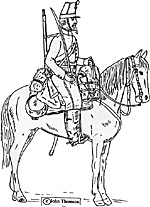 The Chasseurs d'Afrique were formed in
November 1831 consisting of 2 regiments composed of both native
Nort Africans and Frenchmen in separate squadrons. In 1832 a 3rd
regiment was formed and a 4th in 1838. In 1841 the native element
were incorporated into the new raised Spahis native cavalry corps
the Chasseurs d'Afrique from then on being exclusively composed
of Frenchmen.
The Chasseurs d'Afrique were formed in
November 1831 consisting of 2 regiments composed of both native
Nort Africans and Frenchmen in separate squadrons. In 1832 a 3rd
regiment was formed and a 4th in 1838. In 1841 the native element
were incorporated into the new raised Spahis native cavalry corps
the Chasseurs d'Afrique from then on being exclusively composed
of Frenchmen.
The 1st and 4th regiments commanded by General d'Altonville formed part of th French expeditionary force in the Crimean War and it was a squadron of the latter which charged and broke up the Russian artillery and its protecting infantry on the left flank of the valley during the charge of the Light Brigade. It prevented the charge and subsequent retreat being an even greater disaster than it was.
The squadron, given covering fire by another squadron deployed as skirmishers, charging in extended order completely disconcerted the Russian infantry and reached the artillery batteries causing them to cease fire. In the course of the action the Chasseurs had two officers killed and 28 men killed or wounded.
Lord Cardigan commander of the British Light Cavalry Brigade following the charge and on returning to the British lines shook the hand of General d'Altonville and thanked him for the Chasseur's intervention. In commemoration of this the officers of the 13th Hussars in later years presented a silver statuette of the regiment's drum horse to the 4th Chasseurs dAfrique and which was conserved in the Chasseur's all of honour until they were disbanded in 1962 and the statuette was given over for safe keepin to the 4th Regiment Chasseurs a Chevel.
The uniform of the Chasseurs d'Afrique in the Crimea was the same as in North Africa. The accompanying illustration is of a trooper. Cap madder red, dark sky blue band and piping, regimental number in white metal on the band in front. Sky blue cord with small button on top rear (for attaching white lines and flounders in full dress), similar cord and button on top front with tricolour cockade beneath, and above a half spherical pompon in squadron colour, being royal blue, crimson, dark green, sky blue, yellow, orange respectively. Black leather peak and chin strap. Waist length jacket sky blue with small yellow painted patch on the collar, small white metal buttons, this was worn for undress and on campaign in place of the full dress long skirted tunic.
Wide woollen red sash. Trousers very loose and wide in cut, madder red with narrow sky blue stripe, 5 pleats each side in front and black leather false boots from the knee down. Short black boots and steel spurs. White shoulder pouch belt with black leather pouch behind, brass circular buckle, slide and tip and enade device in front with a narrow chain attached to a ring below the bomb part and a pricker at the end inserted behind the flames. Narrow white waist belt with brass 5 hook fastener and sword sling rings, the slings also white. Light cavalry 1822 pattern sword with brass hilt guard, steel scabbard . Short Dragoon pattern percussion cap rifle with white sling and 2 pistols. All horse harness black leather, steel bit. Goat or sheepskin rolled behind the saddle containing personal effects and change of linen and below and in front of this canvas ration bag and cooking utensil, in this case a 4 man plate. On the opposite side was secured a picketing and forage rope. In front of the saddle rolled light grey cloak, pistol holster each side, grey white tent roll and foot cover generally grey brown colour, and on the left side attached the African troops special skin water bottle.
Beneath the saddle a grey cover, white girth. The horses were dappled greys and mainly bays.
Source :
'Carnet de la Sabretache' special number 1974 Les Chasseurs d'Afrique.
'Uniformes' magazine no.71 Jan. 1983 Les Chasseurs d'Afrique 1854-70.
'Guide a Vusage des Artistes et Costumiers 1780-1848' H. Malibran.
Back to Age of Empires Issue 14 Table of Contents
Back to Age of Empires List of Issues
Back to MagWeb Master List of Magazines
© Copyright 1998 by Partizan Press.
This article appears in MagWeb (Magazine Web) on the Internet World Wide Web.
Other military history articles and gaming articles are available at http://www.magweb.com